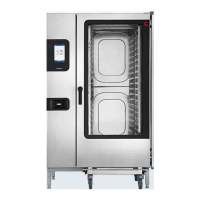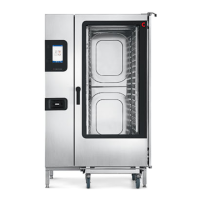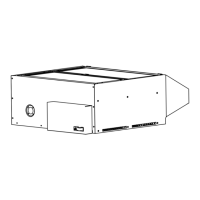Risk / hazard Where and in which situations will
the risk/hazard exist?
What to do / safety equipment
Crush hazard if the unit
topples over
■
Whenever moving the units across
uneven surfaces or after bumping
into an obstacle
■
Whenever the connections are not
disconnected before lifting
■
Whenever the unit is not posi‐
tioned correctly
■
Whenever the supporting surface
is not stable and even
■
Secure the units so that they can‐
not topple over
■
Use suitable equipment and as‐
sembly aids to transport the units
■
Set up the units on an even and
stable supporting surface
■
Disconnect the connections
■
Place the unit on the locating pins
correctly and screw it in place
Safety device:
■
Wall anchoring kit (optional)
■
Locating pins and screw joints
■
Marine model: Feet that can be
screwed onto the floor
■
Whenever the top unit is loaded
with a lot of weight
■
When moving the stacking kit
■
When placing the unit on its back
Exercise caution when performing
maintenance work
Contact with cleaning
agents
When cleaning agent tubes are
damaged or cut by sharp compo‐
nents
Follow the installation sequence in
the instructions
Risk of scalding Whenever opening the bottom unit’s
door
Exercise caution when performing
maintenance work
Fall hazard as a result
of wet floors
When cleaning agent tubes are
damaged or cut by sharp compo‐
nents
Check to make sure that the clean‐
ing agent tubes are routed properly
Pinch point hazard for
hands and fingers
When installing the side panels
■
Exercise caution when performing
maintenance work
■
Wear the required personal pro‐
tective equipment
Risk of burns posed by
hot surfaces
■
On the exhaust duct
■
On the exhaust ducts
■
Everywhere on the inside
■
On the outside of the unit door
■
Wear the required personal pro‐
tective equipment
■
Let the units cool down before per‐
forming maintenance
Cut hazard
■
When knocking out the perforated
knockout on the front plate
■
When knocking out the perforated
knockout on the top unit’s bottom
■
Exercise caution when performing
maintenance work
■
Wear the required personal pro‐
tective equipment
■
Remove the knockout as indicated
in the instructions and deburr the
corresponding edges
2 For Your Safety
12

